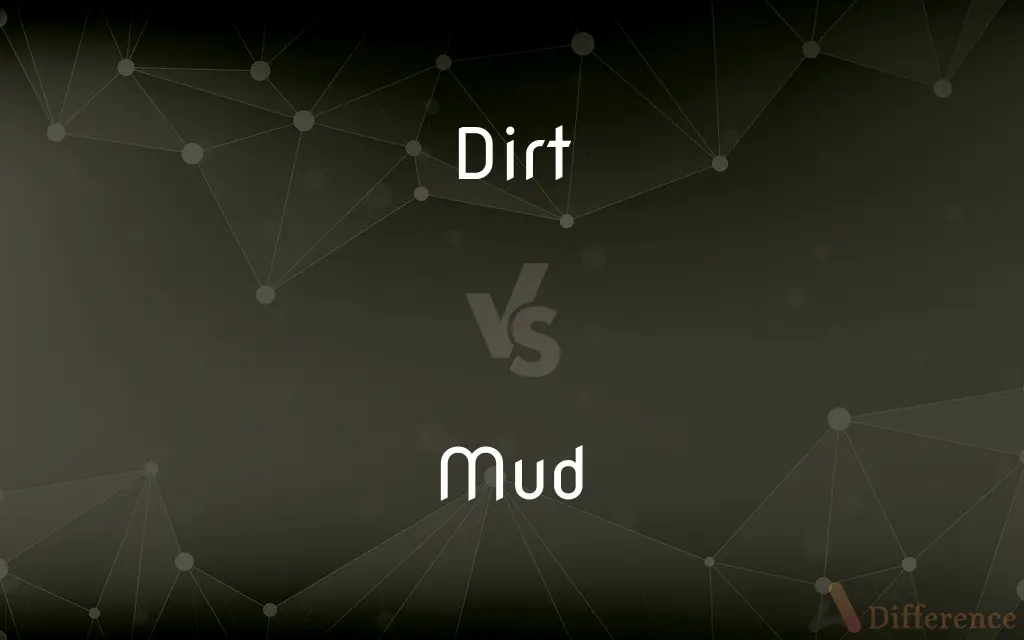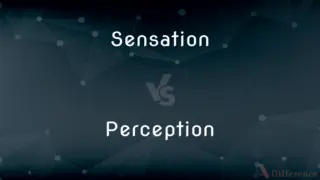Dirt vs. Mud — What's the Difference?
By Maham Liaqat & Urooj Arif — Updated on April 8, 2024
Dirt is loose soil or earth, typically dry and found on the ground, while mud is a wet mixture of soil and water, often sticky and malleable.

Difference Between Dirt and Mud
Table of Contents
ADVERTISEMENT
Key Differences
Dirt refers to the loose top layer of the earth's surface, consisting of soil, sand, and organic matter. It is generally dry and can vary in texture and color based on its composition. On the other hand, mud is created when water mixes with dirt, transforming it into a wet, sticky substance that can adhere to surfaces and mold into shapes. This distinction highlights how the presence of water fundamentally alters the properties and uses of dirt.
While dirt is often associated with dry, barren landscapes or the unwanted accumulation in homes and on objects, mud is linked to wetter environments and can be both a nuisance and a useful material. For example, mud is considered a problem when it sticks to shoes and floors, whereas dirt might be considered a nuisance when it dusts surfaces or is tracked indoors.
In construction and art, the properties of dirt and mud are utilized differently. Dirt can provide a stable foundation when compacted, and it's also used in gardening and landscaping to support plant life. Mud, with its adhesive and pliable qualities, is used in making bricks, pottery, and in certain building techniques like cob construction.
The transformation from dirt to mud can have significant ecological and environmental impacts. Dirt supports ecosystems by serving as a medium for plant growth and habitat for various organisms. When it becomes mud, it can either be beneficial, as in the case of nourishing wetlands, or problematic, like in landslides or when it contaminates waterways.
People's interactions with dirt and mud vary culturally and contextually. Children might play in dirt and mud alike, exploring their textures and uses, but adults typically regard them differently in terms of cleanliness and orderliness. Dirt might be seen as something to be removed or covered, while mud might be seen as a temporary, often enjoyable, mess.
ADVERTISEMENT
Comparison Chart
Composition
Dry soil, sand, and organic matter
Mixture of soil and water
Texture
Loose and granular
Wet, sticky, and pliable
Environmental Role
Supports ecosystems, used for planting
Can form habitats, used in construction and art
Nuisance Level
Considered dirty, often removed from indoor spaces
Can be messy, sticks to surfaces
Usefulness
In landscaping, as a foundation for structures
In making bricks, pottery, and natural building methods
Compare with Definitions
Dirt
Loose, dry soil covering the ground.
She planted the seeds in the dirt and awaited their growth.
Mud
Wet soil, sticky and malleable.
The children played in the mud, making shapes and figures.
Dirt
Earthy material, can accumulate as grime.
After the hike, their boots were covered in dirt.
Mud
Can be used in building materials.
The ancient house was made of bricks baked from mud.
Dirt
Used in gardening and construction.
The landscaper brought in fresh dirt to enhance the garden's soil.
Mud
Essential for certain ecosystems.
The wetland's mud supports a diverse range of life.
Dirt
Symbol of cleanliness issues.
Cleaning the dirt off the floor took hours.
Mud
Artistic and therapeutic medium.
Mud is used in pottery and sometimes in spa treatments.
Dirt
Foundation material.
The builders compacted the dirt before laying the foundation.
Mud
A nuisance when wet and sticky.
After the rain, the park path was covered in mud.
Dirt
Dirt is unclean matter, especially when in contact with a person's clothes, skin or possessions. In such case they are said to become dirty.
Mud
Mud is soil, loam, silt or clay mixed with water. It usually forms after rainfall or near water sources.
Dirt
Earth or soil.
Mud
A computer-based text or virtual reality game which several players play at the same time, interacting with each other as well as with characters controlled by the computer.
Dirt
A filthy or soiling substance, such as mud or dust.
Mud
A computer program, usually running over the internet, that allows multiple users to participate in virtual-reality role-playing games.
Dirt
Excrement.
Mud
Wet, sticky, soft earth, as on the banks of a river.
Dirt
A squalid or filthy condition.
Mud
(Slang) Wet plaster, mortar, or cement.
Dirt
One that is mean, contemptible, or vile.
Mud
Slanderous or defamatory charges or comments
Slinging mud at his opponent.
Dirt
Obscene language or subject matter.
Mud
To cover or spatter with or as if with mud.
Dirt
Malicious or scandalous gossip.
Mud
A mixture of water and soil or fine grained sediment.
Dirt
Information that embarrasses or accuses.
Mud
A plaster-like mixture used to texture or smooth drywall.
Dirt
Unethical behavior or practice; corruption.
Mud
(construction industry slang) Wet concrete as it is being mixed, delivered and poured.
Dirt
Material, such as gravel or slag, from which metal is extracted in mining.
Mud
(figuratively) Willfully abusive, even slanderous remarks or claims, notably between political opponents.
The campaign issues got lost in all the mud from both parties.
Dirt
Soil or earth.
Mud
(slang) Money, dough, especially when proceeding from dirty business.
Dirt
A stain or spot (on clothes etc); any foreign substance that worsens appearance.
Mud
(geology) A particle less than 62.5 microns in diameter, following the Wentworth scale
Dirt
Previously unknown facts, or the invented "facts", about a person.
The reporter uncovered the dirt on the businessman by going undercover.
Mud
A black person.
Dirt
(figurative) Meanness; sordidness.
Mud
Drilling fluid.
Dirt
(mining) In placer mining, earth, gravel, etc., before washing.
Mud
(slang) Coffee.
Dirt
Freckles
Mud
(transitive) To make muddy or dirty; to apply mud to (something).
Dirt
To make foul or filthy; soil; befoul; dirty
Mud
(transitive) To make turbid.
Dirt
Any foul of filthy substance, as excrement, mud, dust, etc.; whatever, adhering to anything, renders it foul or unclean; earth; as, a wagonload of dirt.
Whose waters cast up mire and dirt.
Mud
(intransitive) To go under the mud, as an eel does.
Dirt
Meanness; sordidness.
Honors . . . thrown away upon dirt and infamy.
Mud
To participate in a MUD or multi-user dungeon.
Dirt
In placer mining, earth, gravel, etc., before washing.
Mud
Earth and water mixed so as to be soft and adhesive.
Dirt
To make foul of filthy; to dirty.
Mud
To bury in mud.
Dirt
The part of the earth's surface consisting of humus and disintegrated rock
Mud
To make muddy or turbid.
Dirt
The state of being covered with unclean things
Mud
Water soaked soil; soft wet earth
Dirt
Obscene terms for feces
Mud
Slanderous remarks or charges
Dirt
Disgraceful gossip about the private lives of other people
Mud
Soil with mud, muck, or mire;
The child mucked up his shirt while playing ball in the garden
Dirt
(of roads) not leveled or drained; unsuitable for all year travel
Mud
Plaster with mud
Common Curiosities
Can dirt become mud?
Yes, when water is added to dirt, it becomes mud.
Is mud always considered dirty?
While often associated with messiness, mud can also be considered beneficial in contexts like construction, art, and play.
Why is dirt important for plant growth?
Dirt provides nutrients and a physical medium necessary for plant roots to grow and access water and air.
How does mud affect construction?
Mud can be both beneficial as a building material in certain techniques and problematic by making construction sites slippery and difficult to work on.
What is the primary difference between dirt and mud?
The primary difference lies in their moisture content; dirt is dry, while mud is a mixture of dirt and water.
How do dirt and mud impact water quality?
Excessive dirt and mud entering waterways can decrease water quality by increasing turbidity and contaminating it with pollutants.
Are there environments that depend on mud?
Yes, environments like wetlands and mudflats rely on mud for their ecological health and biodiversity.
Do all cultures view dirt and mud the same way?
Cultural perceptions of dirt and mud vary, with some seeing them as purely messy, while others recognize their practical and symbolic importance.
What role does mud play in agriculture?
Mud can be beneficial for retaining moisture in soil and is sometimes used in organic farming methods.
What makes mud sticky?
The combination of water and fine particles in soil gives mud its sticky texture.
Is it possible to purify mud to make it into clean water and dirt?
Through processes like sedimentation and filtration, mud can be separated back into water and dirt particles.
Can mud be considered a renewable resource?
Yes, as long as soil and water are available, mud can be considered a renewable resource, useful in sustainable building practices.
What are the health implications of playing in dirt and mud?
Playing in dirt and mud can strengthen the immune system but also poses a risk if the soil is contaminated with harmful substances.
Can dirt and mud be cleaned easily?
Dirt, being dry, is generally easier to clean and remove than mud, which can adhere to surfaces and require more effort to remove.
How are dirt and mud used in art?
Artists use mud for its texture and plasticity in sculpture and pottery, while dirt can be used in earthworks and environmental art.
Share Your Discovery

Previous Comparison
Sensation vs. Perception
Next Comparison
Manga vs. MangakaAuthor Spotlight
Written by
Maham LiaqatCo-written by
Urooj ArifUrooj is a skilled content writer at Ask Difference, known for her exceptional ability to simplify complex topics into engaging and informative content. With a passion for research and a flair for clear, concise writing, she consistently delivers articles that resonate with our diverse audience.
















































